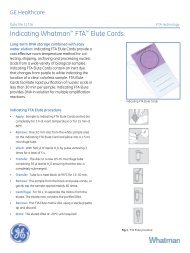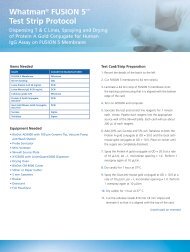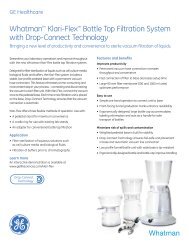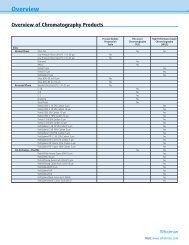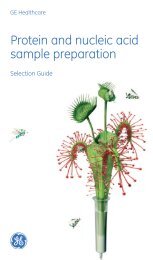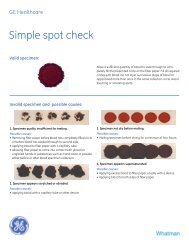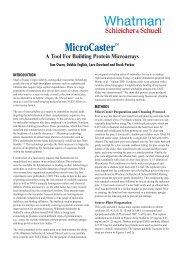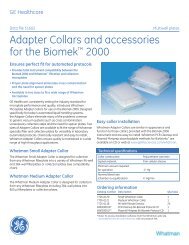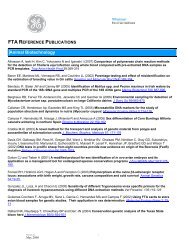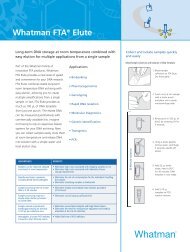384-Well PCR Purification Using the DNA Binding - Whatman
384-Well PCR Purification Using the DNA Binding - Whatman
384-Well PCR Purification Using the DNA Binding - Whatman
Create successful ePaper yourself
Turn your PDF publications into a flip-book with our unique Google optimized e-Paper software.
<strong>Whatman</strong>® Application Note<br />
Introduction<br />
The purification of <strong>PCR</strong> products is a commonly used<br />
practice in many of today’s molecular biology labs. The<br />
purpose of <strong>the</strong> cleanup step is to purify <strong>PCR</strong> amplification<br />
products away from undesirable reaction components<br />
such as salts, excess nucleotides, primers, adjuncts<br />
and proteins (e.g., Taq polymerase). The removal of<br />
<strong>the</strong>se components improves <strong>the</strong> reliability of downstream<br />
analytical methods routinely performed in genomics<br />
labs, <strong>the</strong>reby increasing process flow and decreasing<br />
handling costs.<br />
The <strong>Whatman</strong> <strong>384</strong>-<strong>Well</strong> <strong>DNA</strong> <strong>Binding</strong> Plate contains a<br />
unique membrane engineered for <strong>the</strong> high throughput<br />
preparation of double-stranded <strong>DNA</strong>. This plate, toge<strong>the</strong>r<br />
with <strong>the</strong> simple method described below, will provide a<br />
high throughput, low cost procedure for purifying <strong>PCR</strong><br />
products for downstream applications such as <strong>DNA</strong><br />
sequencing or microarray printing.<br />
Materials<br />
The <strong>Whatman</strong> plates used in this application are<br />
O <strong>384</strong>-<strong>Well</strong> <strong>DNA</strong> <strong>Binding</strong> Plate (Cat. No. 7700-2110)<br />
O <strong>384</strong>-<strong>Well</strong> 400µL Waste Collection Plate<br />
(Cat. No. 7701-5400)<br />
O <strong>384</strong>-<strong>Well</strong> 100µL Collection Plate<br />
(Cat. No. 7701-1100)<br />
The solutions used in this application are<br />
O <strong>DNA</strong> <strong>Binding</strong> Buffer 20% 8M Guanidine<br />
Hydrochloride: 80% Ethanol (v/v)<br />
O Wash Buffer 20% 100mM Tris, 20mM EDTA, 0.4M<br />
NaCl, pH 7.5: 80% Ethanol (v/v)<br />
O Elution Buffer 10mM Tris, 0.1mM EDTA, pH 7.5<br />
Alternatively, nuclease free water can be used for elution<br />
of <strong>the</strong> <strong>PCR</strong> amplification products. O<strong>the</strong>r equipment<br />
required for this protocol include a microplate centrifuge<br />
capable of accommodating a 5.85cm (2.3 inch) stack<br />
height, a pipetting system and commercially available<br />
aerosol resistant pipet tips (>100µL fill volume).<br />
N<br />
Techniques and Technical Insight to Optimize Use of <strong>Whatman</strong> Products<br />
<strong>384</strong>-<strong>Well</strong> <strong>PCR</strong> <strong>Purification</strong> <strong>Using</strong><br />
<strong>the</strong> <strong>DNA</strong> <strong>Binding</strong> Filter Plate<br />
N<br />
CL<br />
Methods<br />
<strong>PCR</strong> Amplification<br />
Amelogenin <strong>PCR</strong> product (213bp) was amplified using <strong>the</strong><br />
Promega GenePrint ® Sex ID kit. Two fragments from<br />
pGEM/luc plasmid (500bp and 1.9kb) were also amplified<br />
using custom primers and Promega <strong>PCR</strong> reagents.<br />
<strong>PCR</strong> Cleanup Procedure<br />
This procedure can be performed on any liquid handling<br />
robot and uses a <strong>384</strong>-well purification format adaptable for<br />
processing 5 to 30µL <strong>PCR</strong> reactions from ei<strong>the</strong>r 96 or<br />
<strong>384</strong>-<strong>Well</strong> <strong>the</strong>rmal cycling plates. The method described here<br />
was carried out on a Biomek ® 2000 (Beckman Coulter)<br />
liquid handling robot and <strong>the</strong> GP8 centrifuge from Thermo IEC.<br />
96-<strong>Well</strong> <strong>PCR</strong> Plates containing 25µL amplified <strong>DNA</strong> were<br />
placed on <strong>the</strong> Biomek 2000 work surface equipped with left<br />
and right side modules, buffer reservoirs, and <strong>the</strong> MP200<br />
pipetting tool (8-channel). <strong>DNA</strong> <strong>Binding</strong> Buffer (60µL) was<br />
added directly to each amplification reaction and mixed 4<br />
times using a medium pipetting speed and a 60µL mix<br />
volume. The contents were <strong>the</strong>n transferred to <strong>the</strong> <strong>384</strong>-<strong>Well</strong><br />
<strong>DNA</strong> <strong>Binding</strong> Plate using a slow aspirate and dispense<br />
speed followed by a 10µL blowout in order to maximize<br />
volume transfer.<br />
For reactions performed in <strong>384</strong>-<strong>Well</strong> <strong>PCR</strong> Plates or plates<br />
with working volumes less than 85µL, 35µL of <strong>the</strong> <strong>DNA</strong><br />
<strong>Binding</strong> Buffer was first added to each well of <strong>the</strong> <strong>384</strong>-<strong>Well</strong><br />
<strong>DNA</strong> <strong>Binding</strong> Plate. The <strong>PCR</strong> mixture was <strong>the</strong>n transferred<br />
from <strong>the</strong> <strong>PCR</strong> plate to <strong>the</strong> wells of <strong>the</strong> <strong>DNA</strong> <strong>Binding</strong> Plate.<br />
The wells of <strong>the</strong> <strong>PCR</strong> plate were rinsed with 25µL of <strong>DNA</strong><br />
<strong>Binding</strong> Buffer, which was added to <strong>the</strong> corresponding wells<br />
of <strong>the</strong> <strong>DNA</strong> <strong>Binding</strong> Plate. The contents of <strong>the</strong> wells were<br />
mixed 3 times using a medium pipetting speed and a mix<br />
volume equal to 40% of <strong>the</strong> total solution volume. A postmixing<br />
delay of 2 - 5 seconds with a 10µL blow out was<br />
performed to completely clear <strong>the</strong> viscous liquid from <strong>the</strong><br />
pipet tips.<br />
The <strong>384</strong>-<strong>Well</strong> <strong>DNA</strong> <strong>Binding</strong> Plate stacked on top of a 400µL<br />
Waste Collection Plate was placed in <strong>the</strong> centrifuge and<br />
filtered at 1,800xg for 2.5 minutes. Two sequential wash<br />
steps were <strong>the</strong>n performed, each through automated<br />
addition of 90µL of <strong>the</strong> Wash Buffer followed by centrifugation<br />
at 1,800xg at 2.5 and 5 minutes respectively. The<br />
purified <strong>DNA</strong> was eluted by adding 50µL of Elution Buffer to<br />
each well, incubating for 1 minute and centrifuge filtering<br />
(1800xg for 2.5 minutes) into a 100µL collection plate.
<strong>DNA</strong> Quantitation for Recovery Evaluation<br />
The PicoGreen ® detection systems (Molecular Probes) was<br />
used to quantitate double-stranded <strong>PCR</strong> product. Percent<br />
recovery was calculated by comparison of purified vs.<br />
unpurified <strong>PCR</strong> product quantitation.<br />
<strong>DNA</strong> Sequencing<br />
<strong>DNA</strong> sequencing was performed using BigDye Terminator<br />
reaction chemistry (v 2.0) and <strong>the</strong> ABI Prism ® 3100 Genetic<br />
Analyzer. Amplification was conducted at 1/4 strength by<br />
combining 2µL purified amplicon and 8µL deionized H 2O<br />
(containing 1.6 pmol primer) and 2µL BigDye reagent.<br />
Purity of <strong>PCR</strong> Products after Cleanup<br />
Primer removal: The OliGreen ® single-stranded <strong>DNA</strong> detection<br />
system from Molecular Probes was used to quantitate<br />
initial and final primer concentrations for <strong>PCR</strong> reactions.<br />
Protein removal: <strong>PCR</strong> reactions containing varying<br />
concentrations of BSA or Taq polymerase were tested<br />
before and after <strong>PCR</strong> cleanup using <strong>the</strong> MicroBCA reagent system from Pierce Immunochemicals.<br />
Nucleotide removal: Nucleotide concentrations were<br />
measured spectrophotometrically at 260nm using reactions<br />
devoid of primers, target <strong>DNA</strong> and Taq polymerase.<br />
Results<br />
<strong>DNA</strong> Recovery and Consistency<br />
Amplified <strong>DNA</strong> fragments of varying size were purified<br />
using <strong>the</strong> <strong>Whatman</strong> <strong>384</strong>-<strong>Well</strong> <strong>DNA</strong> <strong>Binding</strong> Plate and <strong>the</strong><br />
protocol outlined in <strong>the</strong> “Methods” section. Recovery of<br />
<strong>the</strong> fragments exceeded 90% in all instances (Figure 1).<br />
Recovery for <strong>PCR</strong> mixtures, distributed evenly across <strong>the</strong><br />
<strong>384</strong>-<strong>Well</strong> <strong>DNA</strong> <strong>Binding</strong> Plates, exhibited low variability from<br />
well to well (< 8% CV) ensuring a standard purification<br />
performance across <strong>the</strong> entire plate. <strong>Using</strong> <strong>the</strong> Biomek 2000<br />
equipped with an 8-channel pipetting head <strong>the</strong> processing<br />
times were approximately 1:25:10 and 2:36:50 for 2 and<br />
4 plates, respectively.<br />
5.00 100.0%<br />
4.50<br />
4.00<br />
3.50<br />
Crude Input (µg)<br />
<strong>DNA</strong> Yield (µg)<br />
% Recovery<br />
98.0%<br />
96.0%<br />
3.00<br />
2.50<br />
94.0%<br />
2.00<br />
92.0%<br />
1.50<br />
90.0%<br />
1.00<br />
0.50<br />
88.0%<br />
0.00<br />
213bp Amelogenin 500bp pGEM<br />
<strong>PCR</strong> Product<br />
1.9kb pGEM<br />
86.0%<br />
Figure 1. <strong>PCR</strong> product pools for 3 different fragments run in parallel<br />
using <strong>the</strong> <strong>Whatman</strong> <strong>384</strong>-<strong>Well</strong> <strong>PCR</strong> Cleanup Method on <strong>the</strong> Biomek 2000.<br />
Recoveries were determined by Picogreen analysis of input vs purified<br />
<strong>PCR</strong> products.<br />
<strong>DNA</strong> Quantity (µg/well)<br />
% Recovery<br />
<strong>Well</strong> to <strong>Well</strong> Discrimination<br />
Critical to multiwell applications is <strong>the</strong> proof that well to<br />
well crosstalk does not occur. To illustrate this point, a<br />
1.9kb pGEM insert was amplified and subsequently<br />
purified in alternate wells in a <strong>384</strong>-<strong>Well</strong> <strong>DNA</strong> <strong>Binding</strong> Plate.<br />
Buffer was added to <strong>the</strong> intervening wells as a blank.<br />
Following <strong>the</strong> <strong>PCR</strong> cleanup procedure, all wells were<br />
reamplified using sensitive nested <strong>PCR</strong> primers. If crosstalk<br />
had occurred <strong>the</strong>n <strong>the</strong> wells receiving buffer would<br />
amplify a product. As can be seen in Figure 2, only <strong>the</strong><br />
wells that contained <strong>the</strong> true <strong>PCR</strong> product were amplified.<br />
Figure 2. Alternating positive and negative <strong>PCR</strong> purification<br />
(1.9kb pGEM insert <strong>PCR</strong> product). An aliquot of each eluate was<br />
reamplified in a 25µL <strong>PCR</strong> reaction with nested primers. The<br />
nested <strong>PCR</strong> was run on a 1% agarose gel and visualized with<br />
ethidium bromide.<br />
Effects of Adjuncts on <strong>PCR</strong> Cleanup<br />
To enhance <strong>PCR</strong> processivity or to alleviate problems<br />
due to template sequence, adjuncts are added to <strong>the</strong><br />
<strong>PCR</strong> mixture. Common additives such as DMSO,<br />
glycerol and betaine, while enhancing <strong>the</strong> amplification<br />
reaction, can interfere with downstream <strong>PCR</strong> cleanup.<br />
Betaine is known to interfere with silica-based cleanup<br />
procedures resulting in low yield and recovery.<br />
To test <strong>the</strong> effects of <strong>the</strong>se additives on double-stranded<br />
<strong>DNA</strong> binding to <strong>the</strong> <strong>384</strong>-well <strong>DNA</strong> <strong>Binding</strong> Plate, we<br />
added increasing quantities of herring sperm <strong>DNA</strong> in<br />
standard <strong>PCR</strong> buffer conditions (10 mM Tris, pH 9,<br />
50 mM KCl,1.5 mM MgCl 2 and 0.1 % Triton X-100)<br />
to <strong>the</strong> <strong>DNA</strong> <strong>Binding</strong> Plate in <strong>the</strong> presence or absence<br />
of 2% DMSO, 1.5M Betaine or 0.1% Glycerol. As can<br />
be seen in Figure 3, DMSO and Glycerol have no effect<br />
on binding of <strong>DNA</strong> to <strong>the</strong> <strong>DNA</strong> <strong>Binding</strong> Plate. Betaine<br />
caused a slight reduction (~15%) in yield.<br />
An important observation from this study is <strong>the</strong> high<br />
binding capacity of <strong>the</strong> <strong>384</strong>-<strong>Well</strong> <strong>DNA</strong> <strong>Binding</strong> Plate<br />
which is > 7µg/well.
<strong>DNA</strong> Yield (µg/well)<br />
Effect of Additives on <strong>384</strong>-<strong>Well</strong> <strong>PCR</strong> Cleanup<br />
10<br />
9<br />
8<br />
7<br />
6<br />
5<br />
4<br />
3<br />
2<br />
1<br />
0<br />
0 2 4 6 8 10<br />
HS <strong>DNA</strong> Input (µg/well)<br />
Standard <strong>PCR</strong> 2% DMSO 1.5M Betaine 0.1% Glycerol<br />
Figure 3. Herring Sperm <strong>DNA</strong> was added to <strong>the</strong> wells of <strong>the</strong> <strong>384</strong>-<strong>Well</strong><br />
<strong>DNA</strong> <strong>Binding</strong> Plate in <strong>the</strong> presence an absence of additives. <strong>DNA</strong><br />
recovery was measured following elution using PicoGreen.<br />
Removal of <strong>PCR</strong> Contaminants<br />
Important for downstream processing is <strong>the</strong> removal of<br />
excess primers, nucleotides and protein contaminants<br />
from <strong>the</strong> <strong>PCR</strong> product. Contaminants are hazardous for<br />
automated sequencing and for microarray analysis of<br />
<strong>PCR</strong> amplicons.<br />
The <strong>Whatman</strong> <strong>384</strong>-<strong>Well</strong> <strong>PCR</strong> Cleanup protocol was<br />
designed to eliminate contaminants in <strong>the</strong> final <strong>PCR</strong><br />
product to ensure <strong>the</strong>ir optimal use in downstream<br />
processing. The <strong>Whatman</strong> protocol removes > 92%<br />
and 100% of <strong>the</strong> excess primers and nucleotides,<br />
respectively (Figure 4). Critical for microarray spotting<br />
of <strong>PCR</strong> products, <strong>the</strong> <strong>384</strong>-<strong>Well</strong> <strong>PCR</strong> Cleanup protocol<br />
removes > 95% of proteins including <strong>the</strong> 94 Kd Taq <strong>DNA</strong><br />
polymerase routinely retained by ultra-filtration methods.<br />
% Removal<br />
102%<br />
100%<br />
98%<br />
96%<br />
94%<br />
92%<br />
90%<br />
88%<br />
86%<br />
Removal of <strong>PCR</strong> Contaminants<br />
Primer removal Protein removal Nucleotide removal<br />
Figure 4. Removal of unincorporated <strong>PCR</strong> components<br />
<strong>DNA</strong> Sequencing<br />
To fur<strong>the</strong>r demonstrate <strong>the</strong> purity of <strong>the</strong> <strong>PCR</strong> products<br />
isolated with <strong>the</strong> <strong>Whatman</strong> protocol and <strong>384</strong>-well <strong>DNA</strong><br />
<strong>Binding</strong> Plate, we sequenced fragments via sensitive<br />
capillary sequencing. It is widely accepted that contaminating<br />
salts and residual alcohol will interfere with <strong>DNA</strong> sequencing<br />
reactions. Good quality sequencing results were obtained<br />
using <strong>the</strong> 1.9 kb <strong>PCR</strong> product as a template (Figure 5). We<br />
routinely achieved read lengths in excess of 750 bp with 99%<br />
base calling accuracy indicating high template purity.<br />
Figure 5. ABI 3100 pherograph of a 1.9kb <strong>PCR</strong> fragment purified<br />
with <strong>the</strong> <strong>384</strong>-<strong>Well</strong> <strong>DNA</strong> <strong>Binding</strong> Plate and labeled with Big Dye<br />
reaction mix.<br />
Discussion<br />
We have shown <strong>the</strong> validity and <strong>the</strong> utility of <strong>the</strong> <strong>Whatman</strong><br />
<strong>384</strong>-<strong>Well</strong> <strong>DNA</strong> <strong>Binding</strong> Plate for purification of <strong>PCR</strong><br />
products. The method is based on <strong>the</strong> commonly used<br />
silica “bind, wash and elute” process that has been widely<br />
accepted as yielding highly purified <strong>DNA</strong> for analysis.<br />
Adaptable to many commonly used liquid handling robots,<br />
this method is automation friendly. <strong>Using</strong> an indexing<br />
centrifuge as part of <strong>the</strong> robotics platform, <strong>the</strong> method is<br />
truly a “walk away” system.<br />
The <strong>384</strong>-<strong>Well</strong> <strong>DNA</strong> <strong>Binding</strong> Plate provides a robust support<br />
for isolating <strong>DNA</strong> fragments for downstream processing.<br />
The method is reliable and consistent across <strong>the</strong> entire<br />
plate and does not appear to be affected by agents known<br />
to interfere with 96-well silica binding, such as betaine.<br />
High yields of <strong>DNA</strong> are routinely recovered free of excess<br />
reaction components. The method is quick and requires<br />
easy to prepare buffers made with chemicals routinely<br />
found in most molecular biology labs. Bulk packaging of<br />
plates allows a flexible and cost effective means of <strong>PCR</strong><br />
cleanup.<br />
More information on automated protocols can be found at<br />
www.whatman.com/technical support/applications.
<strong>Whatman</strong>®<br />
North America: <strong>Whatman</strong> Inc. 9 Bridewell Place Clifton, NJ 07014 • Technical Support: 1-800-922-0361 • Customer Service: 1-800-631-7290 • Outside US: 973-773-5800 • Fax: 973-773-0168 • E-mail: info@whatman.com<br />
Europe: <strong>Whatman</strong> International Ltd <strong>Whatman</strong> House St Leonard’s Road 20/20 Maidstone Kent ME16 OLS England • Tel: +44 (0)1622 676670 • Fax: +44 (0)1622 677011 • E-mail: information@whatman.co.uk<br />
Japan: <strong>Whatman</strong> Japan KK Daiwa Ueno Building 1F 6-10 Ueno 5-chome Taito-ku Tokyo 110-0005 Japan • Tel: +81 (0)3 3832 6707 • Fax: +81 (0)3 3832 6457 • E-mail: japaninfo@whatman.co.jp<br />
Asia Pacific: <strong>Whatman</strong> Asia Pacific Pte Ltd 171 Chin Swee Road #08-01 San Centre Singapore 169877 • Tel: +65 6534 0138 • Fax: +65 6534 2166 • E-mail: wap@whatman.com.sg<br />
<strong>Whatman</strong> is a trademark of The <strong>Whatman</strong> Group ©<strong>Whatman</strong> Inc., 2003 Printed in USA 1/03<br />
<strong>PCR</strong> is covered by US patents issued to Hoffman-LaRoche, Inc. All o<strong>the</strong>r trademarks acknowledged.<br />
FOR RESEARCH USE ONLY<br />
NOT FOR USE IN DIAGNOSTIC PROCEDURES.<br />
51619<br />
N<br />
N<br />
CL





